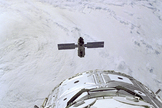
Roscosmos logo
Credit: Roscosmos.
Roscosmos, also known as the Roscosmos State Corporation for Space Activities, is the coordinating hub for space activities in Russia. It performs numerous civilian activities (including Earth monitoring and the astronaut program) and coordinates with the Defense Ministry of the Russian Federation for military launches.
Roscosmos used to be known as the Russian Federal Space Agency, which was formed in 1992. The new corporation was formed from merging the agency and United Rocket and Space Corporation, a joint-stock entity meant to bolster the space sector. Russia’s involvement in space, however, long predates these events. At the height of the former Soviet Union’s space prowess in the 1950s and 1960s, the country racked up several world firsts — including the first human in space .
Roscosmos came to be in a different area, shortly after the breakup of the Soviet Union. The agency poured its scant resources into the International Space Station and to this day remains a major participant in the effort.
The Soviet-U.S. space race
Soviet experience with space threads through much of the past century. Konstantin Tsiolkovsky ‘s pioneering rocketry work extended through the late 19th and early 20th centuries. The Soviets then supplemented that experience with German V2 missile engineers acquired after the end of the Second World War in 1945. The United States had another group of Germans from the same program.
Under the auspices of International Geophysical Year in 1957-58, the Soviets launched the world’s first satellite (Sputnik ). Some in the United States worried about the influence of communism in outer space. As Americans scrambled to catch up, the Soviets accomplished many world firsts. Among them were the first man in space (Yuri Gagarin ), first woman (Valentina Tereshkova ), first lunar flyby (Luna 1) and first three-person crew (Voskhod 1).
Late in the 1960s, the Americans were en route to moon landings and the Soviets had several failures of their N-1 rocket that could also have been used for human lunar exploration. Subsequently, the Soviets focused on space station technology, most notably in the form of the Salyut and the Mir space station programs. Mir hosted the longest human spaceflight to date: Valeri Polyakov , in 1994.
International Space Station contributions
Meanwhile, collaboration was ongoing with the Soviet Union’s former Cold War rival: the United States. It began with the Apollo-Soyuz Test Project of 1975 and continued with a series of NASA astronauts visiting Mir. After the Soviet Union broke apart in 1991, funds reportedly ran thin for the space program. A year later, Roscosmos was formed to coordinate space activities for Russia. Officials elected to focus their resources on the forthcoming International Space Station and de-orbit Mir.

The Space Shuttle Endeavour prepares to rendezvous with the FGB.
Credit: NASA.
Russia was a part of ISS construction from the beginning. In 1998, the Zarya control module was the first element launched . Some (but not all) of Roscosmos’s contributions include the Zvezda service module, a docking hatch, the research module Rassvet , and regular cargo flights to the ISS using Progress spacecraft . Across dozens of flights, Progress has experienced only a handful of failures over the space station’s lifetime (in 2011 and 2015).
Notably, Russia provides the only platform to get humans to the space station right now: Soyuz spacecraft that launch from the Baikonur Cosmodrome in Kazakhstan. The launch complex was formerly a part of the Soviet Union , and is now under lease by the Russians. Russia is eventually aims to move human launches to its own soil, and has built a new complex called Vostochny, which saw its first (robotic) launch in 2016.
Contributing so much hardware allows Russia to send numerous cosmonauts to the station. Many three-person Soyuz crews that head to the station for long-term stays have at least one Russian on board.
Robotic space missions
Roscosmos is a major provider of launch services to other countries. Its Proton rocket line has had a few snags over the years. Three Breeze-M upper stages failed in separate launches across 16 months , prompting a full review in late 2012. Then in 2013, another booster failed 17 seconds after the launch . Satellites were also lost in failure in 2015 and 2015.
In addition to launching satellites for other countries, Roscosmos does numerous satellite missions of its own. Some examples include Earth observation, military satellites , telecommunications , and Glosnass navigation satellites .
In 2013, a fragment of a Chinese satellite (Fengyun 1C) reportedly collided with a small Russian laser-ranging satellite called BLITS (Ball Lens in The Space). The crash knocked BLITS from its original orbit and broke it into at least two fragments.
Russia is now looking ahead to a major Mars mission, ExoMars , which it is doing with the European Space Agency . ExoMars’ first leg (the Trace Gas Orbiter) launched successfully in 2016, while a rover was delayed by two years (due to scheduling problems) until an expected launch in 2020. Roscosmos is hoping the mission will break the streak of several failed Mars missions, most recently the Phobos-Grunt failure that occurred in 2012 when the probe could not break free of Earth’s orbit.
Media reports have said that Russia is interested in developing a series of robotic moon missions, which would be dubbed Luna-Glob . However, budgetary restraints have reportedly pushed back the first of these missions until at least 2025.
Comments are closed.